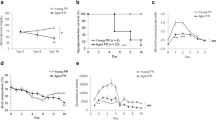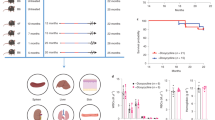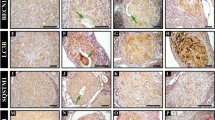Abstract
Autophagy increases the lifespan of model organisms; however, its role in promoting mammalian longevity is less well-established1,2. Here we report lifespan and healthspan extension in a mouse model with increased basal autophagy. To determine the effects of constitutively increased autophagy on mammalian health, we generated targeted mutant mice with a Phe121Ala mutation in beclin 1 (Becn1F121A/F121A) that decreases its interaction with the negative regulator BCL2. We demonstrate that the interaction between beclin 1 and BCL2 is disrupted in several tissues in Becn1F121A/F121A knock-in mice in association with higher levels of basal autophagic flux. Compared to wild-type littermates, the lifespan of both male and female knock-in mice is significantly increased. The healthspan of the knock-in mice also improves, as phenotypes such as age-related renal and cardiac pathological changes and spontaneous tumorigenesis are diminished. Moreover, mice deficient in the anti-ageing protein klotho3 have increased beclin 1 and BCL2 interaction and decreased autophagy. These phenotypes, along with premature lethality and infertility, are rescued by the beclin 1(F121A) mutation. Together, our data demonstrate that disruption of the beclin 1–BCL2 complex is an effective mechanism to increase autophagy, prevent premature ageing, improve healthspan and promote longevity in mammals.
This is a preview of subscription content, access via your institution
Access options
Access Nature and 54 other Nature Portfolio journals
Get Nature+, our best-value online-access subscription
$32.99 / 30 days
cancel any time
Subscribe to this journal
Receive 51 print issues and online access
$199.00 per year
only $3.90 per issue
Buy this article
- Purchase on SpringerLink
- Instant access to full article PDF
Prices may be subject to local taxes which are calculated during checkout




Similar content being viewed by others
Change history
19 June 2018
In this Letter, the graphs in Fig. 2a and c were inadvertently the same owing to a copy and paste error from the original graphs in Prism. The Source Data files containing the raw data were correct. Fig. 2c has been corrected online.
References
Madeo, F., Zimmermann, A., Maiuri, M. C. & Kroemer, G. Essential role for autophagy in life span extension. J. Clin. Invest. 125, 85–93 (2015).
Rubinsztein, D. C., Mariño, G. & Kroemer, G. Autophagy and aging. Cell 146, 682–695 (2011).
Kuro-o, M. et al. Mutation of the mouse klotho gene leads to a syndrome resembling ageing. Nature 390, 45–51 (1997).
Levine, B. & Kroemer, G. Autophagy in the pathogenesis of disease. Cell 132, 27–42 (2008).
Meléndez, A. et al. Autophagy genes are essential for dauer development and life-span extension in C. elegans. Science 301, 1387–1391 (2003).
Yamamoto, T. et al. Time-dependent dysregulation of autophagy: Implications in aging and mitochondrial homeostasis in the kidney proximal tubule. Autophagy 12, 801–813 (2016).
Eisenberg, T. et al. Cardioprotection and lifespan extension by the natural polyamine spermidine. Nat. Med. 22, 1428–1438 (2016).
Eisenberg, T. et al. Induction of autophagy by spermidine promotes longevity. Nat. Cell Biol. 11, 1305–1314 (2009).
Mercken, E. M. et al. SIRT1 but not its increased expression is essential for lifespan extension in caloric-restricted mice. Aging Cell 13, 193–196 (2014).
Pyo, J. O. et al. Overexpression of Atg5 in mice activates autophagy and extends lifespan. Nat. Commun. 4, 2300 (2013).
Kimmey, J. M. et al. Unique role for ATG5 in neutrophil-mediated immunopathology during M. tuberculosis infection. Nature 528, 565–569 (2015).
Liang, X. H. et al. Induction of autophagy and inhibition of tumorigenesis by beclin 1. Nature 402, 672–676 (1999).
Kihara, A., Kabeya, Y., Ohsumi, Y. & Yoshimori, T. Beclin-phosphatidylinositol 3-kinase complex functions at the trans-Golgi network. EMBO Rep. 2, 330–335 (2001).
Levine, B., Liu, R., Dong, X. & Zhong, Q. Beclin orthologs: integrative hubs of cell signaling, membrane trafficking, and physiology. Trends Cell Biol. 25, 533–544 (2015).
Rocchi, A. et al. A Becn1 mutation mediates hyperactive autophagic sequestration of amyloid oligomers and improved cognition in Alzheimer’s disease. PLoS Genet. 13, e1006962 (2017).
Pattingre, S. et al. Bcl-2 antiapoptotic proteins inhibit Beclin 1-dependent autophagy. Cell 122, 927–939 (2005).
Sinha, S., Colbert, C. L., Becker, N., Wei, Y. & Levine, B. Molecular basis of the regulation of Beclin 1-dependent autophagy by the γ-herpesvirus 68 Bcl-2 homolog M11. Autophagy 4, 989–997 (2008).
Mizushima, N., Yamamoto, A., Matsui, M., Yoshimori, T. & Ohsumi, Y. In vivo analysis of autophagy in response to nutrient starvation using transgenic mice expressing a fluorescent autophagosome marker. Mol. Biol. Cell 15, 1101–1111 (2004).
Mizushima, N., Yoshimori, T. & Levine, B. Methods in mammalian autophagy research. Cell 140, 313–326 (2010).
McKnight, N. C. et al. Beclin 1 is required for neuron viability and regulates endosome pathways via the UVRAG-VPS34 complex. PLoS Genet. 10, e1004626 (2014).
Lim, J. H. et al. Age-associated molecular changes in the kidney in aged mice. Oxid. Med. Cell. Longev. 2012, 171383 (2012).
Lapierre, L. R., Kumsta, C., Sandri, M., Ballabio, A. & Hansen, M. Transcriptional and epigenetic regulation of autophagy in aging. Autophagy 11, 867–880 (2015).
Brayton, C. in The Mouse in Biomedical Research Vol. 2 (eds Fox, J. et al.), 623–717 (Elsevier, Amsterdam, 2007).
Kuro-o, M. Klotho and aging. Biochim. Biophys. Acta 1790, 1049–1058 (2009).
Tsujikawa, H., Kurotaki, Y., Fujimori, T., Fukuda, K. & Nabeshima, Y. Klotho, a gene related to a syndrome resembling human premature aging, functions in a negative regulatory circuit of vitamin D endocrine system. Mol. Endocrinol. 17, 2393–2403 (2003).
Kurosu, H. et al. Suppression of aging in mice by the hormone Klotho. Science 309, 1829–1833 (2005).
Chen, T. H. et al. The secreted Klotho protein restores phosphate retention and suppresses accelerated aging in Klotho mutant mice. Eur. J. Pharmacol. 698, 67–73 (2013).
Shi, M. et al. αKlotho mitigates progression of AKI to CKD through activation of autophagy. J. Am. Soc. Nephrol. 27, 2331–2345 (2016).
Su, T. et al. Deletion of histidine triad nucleotide-binding protein 1/PKC-interacting protein in mice enhances cell growth and carcinogenesis. Proc. Natl Acad. Sci. USA 100, 7824–7829 (2003).
Sebti, S. et al. BAT3 modulates p300-dependent acetylation of p53 and autophagy-related protein 7 (ATG7) during autophagy. Proc. Natl Acad. Sci. USA 111, 4115–4120 (2014).
Fielding, A. B., Willox, A. K., Okeke, E. & Royle, S. J. Clathrin-mediated endocytosis is inhibited during mitosis. Proc. Natl Acad. Sci. USA 109, 6572–6577 (2012).
Tacheva-Grigorova, S. K., Santos, A. J., Boucrot, E. & Kirchhausen, T. Clathrin-mediated endocytosis persists during unperturbed mitosis. Cell Reports 4, 659–668 (2013).
Wang, C., Li, Q., Redden, D. T., Weindruch, R. & Allison, D. B. Statistical methods for testing effects on “maximum lifespan”. Mech. Ageing Dev. 125, 629–632 (2004).
Motulsky, H. J. & Brown, R. E. Detecting outliers when fitting data with nonlinear regression — a new method based on robust nonlinear regression and the false discovery rate. BMC Bioinformatics 7, 123 (2006).
Acknowledgements
We thank S. Sciarretta for discussions; N. Mizushima for reagents; L. Nguyen for technical assistance and H. Smith for assistance with manuscript preparation. This work was supported by NIH grants RO1-CA109618 (B.L.), U19-AI199725 (B.L.), RO1-DK091392 and RO1-DK092461 (M.C.H. and O.W.M.), P30-DK07938 (O.W.M.), K99R00-DK094980 (C.H.), Cancer Prevention Research Institute of Texas grant RP120718 (B.L.) and a Fondation Leducq grant 15CBD04 (B.L., A.F.F. and S.S.).
Reviewer information
Nature thanks D. Harrison and the other anonymous reviewer(s) for their contribution to the peer review of this work.
Author information
Authors and Affiliations
Contributions
A.F.F., S.S., Y.W., C.H., T.T., Y.L., M.C.H. and B.L. designed the study. A.F.F., S.S., Y.W., Z.Z., M.S., K.L.M. and W.-C.C. performed biochemical analyses. A.F.F., S.S. and Z.Z. performed autophagy microscopic analyses. A.F.F. and S.S. performed renal and cardiac histopathological analyses. G.B. characterized malignancies. A.F.F., S.S., D.K.M., G.G.S, G.B., O.W.M., M.C.H. and B.L. discussed and analysed data. A.F.F., S.S., M.C.H. and B.L. wrote the manuscript. A.F.F. and S.S. contributed equally and the order of these authors was determined arbitrarily.
Corresponding authors
Ethics declarations
Competing interests
B.L. is a Scientific Founder of Casma Therapeutics, Inc.
Additional information
Publisher’s note: Springer Nature remains neutral with regard to jurisdictional claims in published maps and institutional affiliations.
Extended data figures and tables
Extended Data Fig. 1 Increased basal autophagy in tissues of beclin 1(F121A) knock-in mice.
a, Representative images and quantification of GFP–LC3 puncta (autophagosomes) in glomeruli from Becn1+/+;GFP-LC3 (wild-type, WT) and Becn1F121A/F121A;GFP-LC3 (knock-in, KI) mice with or without 50 mg kg−1 chloroquine for 6 h. Scale bars, 10 μm. Data are mean ± s.e.m. for three mice per genotype. b, Enlarged versions of the images shown in Fig. 1c. P values determined by one-sided unpaired t-test. Arrows denote representative GFP–LC3 puncta.
Extended Data Fig. 2 Sustained increase in basal autophagy during adulthood in beclin 1(F121A) knock-in mice.
a, Co-immunoprecipitation of beclin 1 and BCL2 in representative samples of hearts and kidneys from eight-month-old Becn1+/+ (wild-type) and Becn1F121A/F121A (knock-in) animals. b, Quantification of beclin 1 co-immunoprecipitated with BCL2 in indicated tissues of eight-month-old wild-type and knock-in mice (n = 3 mice per genotype). c, Quantification of GFP–LC3 puncta in hearts and tissues from six-month-old Becn1+/+;GFP-LC3 (wild-type) and Becn1F121A/F121A;GFP-LC3 (knock-in) mice with or without chloroquine (50 mg kg−1, 6 h). d, Western blot analysis of autophagy markers in the hearts and kidneys from eight-month-old wild-type and knock-in mice. Each lane represents a different mouse. e, Quantification of p62 and total LC3 levels (normalized to β-actin), as well as LC3-II/LC3-I ratios from samples in d. Data are mean ± s.e.m. for three mice per genotype. P values were determined by one-sided unpaired t-test. For uncropped gels, see Supplementary Fig. 1.
Extended Data Fig. 3 Increased autophagy, but not endocytosis, in beclin 1(F121A) MEFs.
a, Co-immunoprecipitation of beclin 1 and BCL2 in MEFs derived from Becn1+/+ (wild-type) and Becn1F121A/F121A (knock-in) animals. b, Representative images (top) and quantification (bottom) of GFP–LC3 puncta in wild-type and knock-in cells with or without 10 nM bafilomycin A1 (BafA1) for 3 h. Scale bars, 10 µm. c, Western blot analysis of autophagy markers in wild-type and knock-in MEFs with or without BafA1 (100 nM, 2 h). d, Representative images and quantitative electron microscopic analysis of autophagic structures in wild-type and knock-in MEFs with or without BafA1 (100 nM, 3 h). Insets show representative autophagosome (arrowhead) and autolysosome (arrow). Scale bars, 1 µm. e, Representative images and quantification of transferrin uptake kinetics in wild-type and knock-in cells. Scale bars, 20 µm. Results shown are representative of two and four independent experiments respectively for a and c. Data are mean ± s.e.m. for three replicates in b and for 50 cells per genotype and condition in d. Data points on line graph in e denote mean ± s.e.m. for cells at 7 min (n = 63, WT; n = 54, KI), 15 min (n = 58, WT; n = 52 KI), and 30 min (n = 76, WT; n = 83, KI). P values determined by unpaired one-sided (b) and two-sided (d, e) t-test. For uncropped gels, see Supplementary Fig. 1.
Extended Data Fig. 4 Apoptosis and autophagy analyses in kidneys and hearts of aged mice.
a, b, Representative images and quantification of active caspase 3-positive cells in kidneys (a) and hearts (b) from Becn1+/+ (wild-type) and Becn1F121A/F121A (knock-in) animals. Two month-old wild-type and knock-in mouse kidneys and hearts (n = 6 per genotype) were analysed. For kidney analyses, aged (20-month-old) wild-type (n = 20) and knock-in (n = 26) mice were used. For heart analyses, aged (20-month-old) wild-type (n = 19) and knock-in (n = 26) mice were used. Scatter plot bars represent median ± interquartile ranges. P values were determined by two-sided Mann–Whitney test. c, d, Enlarged versions of the endogenous LC3 puncta (autophagosome) images shown in Fig. 3d (c) and Fig. 3h (d). Arrows denote representative LC3 puncta.
Extended Data Fig. 5 In vitro klotho treatment disrupts the beclin 1–BCL2 interaction.
Co-immunoprecipitation of beclin 1 and BCL2 in HeLa cells treated with PBS or the indicated concentrations of recombinant full-length mouse klotho protein for 24 h. Result shown is representative of two independent experiments. For uncropped gels, see Supplementary Fig. 1.
Supplementary information
Supplementary Figures
This file contains Supplementary Figure 1 which shows the uncropped gels for all the main and Extended Data Figures
Rights and permissions
About this article
Cite this article
Fernández, Á.F., Sebti, S., Wei, Y. et al. Disruption of the beclin 1–BCL2 autophagy regulatory complex promotes longevity in mice. Nature 558, 136–140 (2018). https://doi.org/10.1038/s41586-018-0162-7
Received:
Accepted:
Published:
Issue date:
DOI: https://doi.org/10.1038/s41586-018-0162-7
This article is cited by
-
Fludarabine attenuates inflammation and dysregulated autophagy in alveolar macrophages via inhibition of STAT1/IRF1 pathway
Laboratory Animal Research (2025)
-
Structure and activation of the human autophagy-initiating ULK1C:PI3KC3-C1 supercomplex
Nature Structural & Molecular Biology (2025)
-
Mitochondrial quality control in cardiomyocytes: safeguarding the heart against disease and ageing
Nature Reviews Cardiology (2025)
-
Influence of ATG SNPs on hip fracture patients’ functional status
Scientific Reports (2025)
-
Autophagic activity in the midgut cells of three arachnids responds selectively to different modes of overwintering in caves
Protoplasma (2025)




Teresa Dudley
Fig. 2a and c are inadvertently the same due to a copy and paste error from the original graphs in Prism. The source data files with raw data for this figure are correct. Nature will be publishing a correction shortly.
Nature Editorial Administration
Majid Ali
Cellular Declogging, Autophagy, Oxygen-Insulin Signaling Matrix, and Lifespan
At one level, autophagy may be seen as innate “tissue declogging” process for clearing degraded and/or dysfunctional cellular components and molecular debris. In simpler words, autophagy may also be visualized as nature’s detergent system for removing cellular grease to foster conditions for cellular replication and tissue re-modeling. The data of Fernandez et al. (ref. 1) demonstrate that disruption of the beclin 1–BCL2 complex is an effective mechanism to increase autophagy, prevent premature ageing, improve healthspan and promote longevity in mammals. This important work delineates the pathways that link autophagy to lifespan and organspan in mammals. I might also simplify and increase the value of the grease-detergent visual used in deliberations of the health/dis-ease/diseases continuum by clinicians.
In Oxygen and Aging (2000, ref. 2) and follow-up articles (ref. 3-7), this writer, a surgeon (FRCS, Eng.1968) turned-pathologist (Columbia University, New York)-turned clinical integrationist – proposed the oxygen model of health/dis-ease/disease continuum and oxygen model of ageing. For simplification and clarity of communication, one of the visuals offered in these models was of the grease-detergent image in which oxygen serves the role of a detergent for removing grease (comprising peroxidized lipids, tangled protein threads, sugar adducts, and cellular debris) in injured and inflamed tissues. The patients and readers generally benefit from the explanatory power of this image in understanding the mechanisms of action of some spices, herbs, and other natural remedies with empirical benefits of healthful ageing.
In closing, Fernandez et al. consider the possibility that disruption of the beclin 1–BCL2 complex, and ensuant autophagy induction, underlies the anti-ageing mechanism of klotho and perhaps other longevity signaling pathways. This writer also recognizes the possibility that this work might provide the scientific underpinnings of further harvesting the empirical benefits of indigenous remedies that seem to support healthful ageing, notably those involving the oxygen-insulin signaling matrix (ref. 8)
References
1.Fernandez AF, Sebti S, Wei Y, et al. Disruption of the beclin 1-BCL2 autophagy regulatory complex promotes longevity in mice. Nature.2016;558:136-140.
2.Ali M. Oxygen and Aging. (2nd ed.) New York, Canary 21 Press. 2000.
3.Ali M: Oxidative regression to primordial cellular ecology. J Integrative Medicine 1998; 2:4-55.
4.Ali M. Respiratory-to-Fermentative Shift In Immune-Inflammatory Disorders. Energy. Townsend Letter. 2004; 253;64-65.
5.Ali M. The dysox model of aging. Townsend Letter for Doctors and Patients.2005;269:130-134.
6.Ali O. Oxidative coagulopathy in environmental illness. Environmental Management and Health. 2000;11:175-191.
7.Ali M. Darwin, Dysox, and Disease. Volume XI. 3rd. Edi. The Principles and Practice of Integrative Medicine 2000. 3rd. Edi. 2008. New York. (2009) Institute of Integrative Medicine Press.
8.Ali M. Insulin: the life span hormone for healthful aging. Townsend Letter. The examiner of Alternative Medicine 2018;416 (June);54-59.